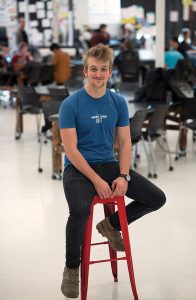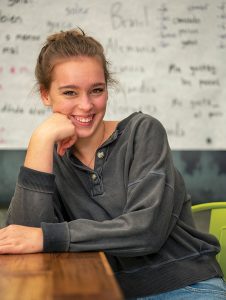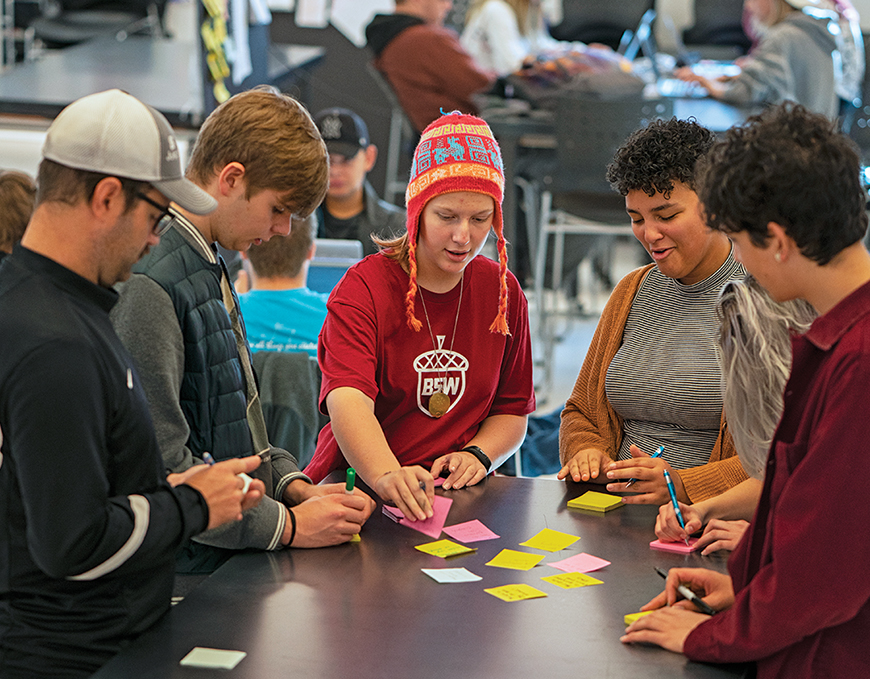When you hear the phrase “alternative school” do you think of kids with learning or physical disabilities, “behavioral issues,” or, perhaps, a freewheeling hippie culture too vague to define?
None of those stereotypes apply to Boise’s One Stone private high school, which describes itself as a student-led and -directed nonprofit with 110 students in grades 10 through 12. Its founders, Joel and Teresa Poppen, wanted a place where students learned leadership, project management, and real-life skills to “change the world.”
At One Stone, there are no grades, classrooms, or tuition; it’s free, supported by the J.A. and Kathryn Albertson Foundation and other donors. A student develops his or her own personalized learning plan, which is regularly evaluated and updated. Coaches (teachers in a traditional school) take their cues from the kids, defying the standard school model.
With a focus on service, empathy, problem-solving, and teamwork, the school’s coaches collaborate with the kids in projects that define a problem, use teamwork to brainstorm ideas to solve it, then design and implement a model of the project. A coach doesn’t impart knowledge; he or she helps a group find out how to get the knowledge they need to design a project.
The overall experience of a student project may include the use of math, English, writing and language skills, advanced research, design, sociology, creative and critical thinking, engineering, construction, leadership, and working in groups of varying sizes. Students also take online classes in math and several more traditional classes in government, philosophy, or other disciplines.
One Stone’s founders and organizers took their cues largely from a methodology called design thinking developed at the d.school of Stanford University as a tool for educators. Design thinking, as described by the originators of the idea, is “a methodology for creative problem solving.” It provides a structure, or a way of organizing, theoretical elements of a project into a hands-on one. It uses creative problem solving to inspire students to design projects that will “disrupt for good” and make lasting change in the world. In all phases of design thinking, empathy is front and center.
A project is launched once a problem is defined: for example, “How might we make the voting process more secure?” The students lead each other in a step called Sticky Note Throwdown, a brainstorming technique that guides students in producing ideas that may be used to design the research process. The project is planned, organized, and implemented by a team. That team may break into smaller teams for specific parts of the plan. When possible,

Ethan Ellis. Photo by Todd Meier
a proposal is taken to a business or organization with the hope of its signing on to the plan. Often, a project becomes a community service improvement, such as a new playground or a redesign of a public space.
Third-year student Ethan Ellis, an engaging fan of the school, said he’s learned “the necessary principles to be a functioning adult. I’m much more able to see a problem from all angles and work well with a team to solve it. It’s important to understand that there is no one answer.”
Ellis transferred from a public school with a strong commitment to community-based projects, but he was looking for more. “I didn’t know what to expect at One Stone, but it has turned out to be profoundly different. Here, we do projects with even more emphasis on community service and empathy. And we try new things as we all find our own passions.” Ellis finds inspiration in the world of first-responders and plans a career there.
Also third year, Kylie Casper told her story with near-poetic reverence for her One Stone experience. She transferred from Boise High, and after her first day she went home in high spirits, thinking, “I made the right decision!”
Casper’s passion this year fell under the school’s Project Good umbrella. Students tackled the problem of homeless kids feeling rootless in their shelters. “Instead of interviewing them to find out what they wanted their rooms to be like, we spent a lot of time just playing with them: taking them on outings, talking, and playing games. We discovered they felt no constant in their lives.” Casper’s team designed a better room for a child, building the furniture and making it both practical and whimsical, all with the participation of the child who would get the room.
Indigo Blauch-Chappell is also a third-year student. Focused and articulate, she is a self-described reserved person who said her first day at the school was “out of my comfort zone” as students experimented with paper rockets they had built. But she felt challenged and inspired. Her passion is in the visual arts, especially pho

Indigo Blauch-Chappell. Photo by Todd Meier
tography, and her latest team project was a redesign of paths and walkways in the Idaho Botanical Gardens to make them more accessible to disabled and elderly visitors. The team worked with the Idaho Commission for the Blind and other advocacy groups. “Our work sparked other changes,” she said, “and now there is an app to help those with accessibility issues navigate the Gardens.”
Former student Sammy Ater, now at the University of Montana, said she wouldn’t trade her One Stone years for anything. “Absolutely, it was the best school experience of my life,” she said. “The methods I learned there prepared me well for college. I still use Sticky Note Throwdowns to organize or design a homework challenge.” She said learning to trust other people’s ideas and working in teams were the most helpful elements of her education. “The confidence I have now comes directly from One Stone.”
“All kids are capable of expression,” said Neva Geisler, the school’s Director of Community Engagement. “Kids who weren’t successful in traditional schools—they are often bored, or find the material irrelevant—thrive here as they connect with their passions. Here they are not afraid to experiment or be different. Here they can be their true selves.”
A SNAPSHOT OF LIFE AT ONE STONE…
Open the front door of One Stone and a ferocious wall of energy spills out. It’s markedly different from a room full of energetic teenagers; it feels more like a small company in the throes of a new project for an important client. The warehouse-like main room is alive with groups that have moved tables and chairs into varying shapes and sizes. The kids are remarkably focused and engaged in what they are doing, and sophisticated round-robin brainstorming sessions have the feel of a university class in creative thinking.
At one big table and presentation area there is a briefing from some academic experts about the politics of gender. At a small table is a group called Project Disruption, focused on an idea about influencing human behavior through visual arts. Students are making a video, an animated cartoon, illustrations, and an album cover.
Smaller class cubicles are headquarters for the various projects currently underway. Design boards make up the walls and the work process is displayed with visuals, research, and artwork. Step in, and you’re enveloped in the specific ideas of one group project.
A standout music student leads a project to design and build a sound studio, now called Ripples. Three students are working on a cover of an AC/DC hit with a re-creation of the ambient noises of the original recording and learning real-world methods of digitizing sound files that could be used by both musicians and businesses. Crammed full of guitars, drums and other instruments, it’s also the headquarters for music lessons.
This is—needless to say—a dynamic learning environment.

